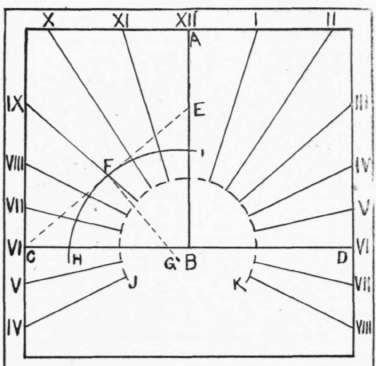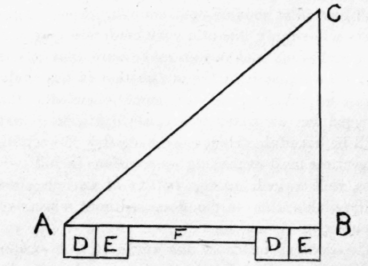A Sundial
Description
This section is from the book "Amateur Work Magazine Vol1". Also available from Amazon: Amateur Work.
A Sundial
In these days of church clocks and dollar watches a sundial may not be necessary as a means of learning the time of day, but as an ornament for the lawn and as a reminder of days long past it serves a useful purpose. The following directions will enable any one to make a sundial that will give fairly correct sun time, which differs in most places from standard time.

Fig. 1.
For the base, procure a piece of well-dried wood 131/2" square and \" thick. This should be planed perfectly smooth, with a small bevel around the edge of the upper side ; mark with a sharp point a line around each side of the top £" from the edge. This will give a square measuring a foot on each side. Four inches from the bottom side draw the line C-D for the six o'clock time (see Fig. 1). From the centers of this line and the top line draw the line A-B. Then draw the line C-E at an angle corresponding to the. latitude of the place where the dial is to be erected. This angle is also used in making the gnomon. Divide the line C-E in the center and at a right angle to it draw the line F-G, which is one-half the length of the line C-E. Using the point G as the center and the line F-G as the radius, describe the arc H-I. Divide this arc from the points where it crosses the lines C-D and A-B into six equal parts, marking lightly each division. From the point B draw lines through these divisions to the lines along the edges, omitting them for a space of about three inches around the point B. These are the hour lines, and both sides of the dial are alike, one side being taken from the other. The lines below the six o'clock line, C-D, are but continuations of the opposite lines above.
The gnomon is the projection above the face of the dial which casts the shadow. (See Fig. 2.) Preferably it is made of stiff sheet brass, which may be polished to increase the ornamental effect. If made of wood, the grain should run perpendicularly and the hour markings on each side should be separated by a space equal to the thickness of the wood. The line A-C is at an angle with the line A-B corresponding to the latitude, as before mentioned. This upper edge is called the style; the base is the substyle. A piece of brass or wood 8" square is required for the gnomon. The base, A-B, is 8" long. The angle of the line A-C determines the height of the side B-C. If of brass, two projections, D and E, are left on each end of the base. These are 1" square, the pieces D being bent to one side and the pieces E to the other. A hole is bored in each piece to receive a round-headed brass screw with which to hold the gnomon firmly erect.

Fig. 2.
If of wood, leave an extension, F, 1/2" deep, which should be well fitted to a socket cut in the base-board, centering on the line A-B. It may be held in place by wire nails, carefully driven from the under side to avoid splitting. When the gnomon is fitted, the base should be well oiled with linseed oil and then painted with two coats of outside white paint. A tube of black paint and a small brush are required for marking the hour lines, which should be about 1/8" wide. First paint the bevel of the edges, then the lines marking the square, then the hour lines. The letters giving the hours complete the marking.
The dial is erected on a firm post and should be perfectly level, with the gnomon or line A-B pointing due north. A compass or the north star may be used to set the dial. If the post is ornamental, it will add to the general appearance.
Continue to:


